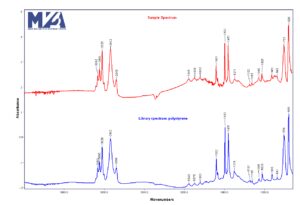Expand Your Knowledge
Our resource center archives our case studies, published articles, blogs, webinars, and image galleries. Discover ways microscopy has made a meaningful impact.

Fourier Transform Infrared Spectroscopy (FTIR) is an important tool in the process of identification of unknown material. FTIR provides specific information about chemical bonding and molecular structure, making it useful for analyzing organic materials and certain inorganic materials. Many materials are partially transparent to infrared light, with different wavelengths of infrared radiation absorbed at different rates.
The identification of unknown compounds can be accomplished by the measurement of the absorption of infrared radiation at different wavelengths, producing an infrared spectrum.
This spectrum is used as a “fingerprint” and compared to the spectrum obtained from a known material or to libraries of reference spectra to identify the compound present.
Because the infrared absorption spectra of mixtures of materials are often difficult to interpret, sample separation techniques such as solvent extraction may be applied prior to analysis.

Comparison of an unknown sample to a reference spectrum from the FTIR library
Fourier Transform Infrared Spectroscopy (FTIR) is a robust and versatile analysis method that can analyze and identify a wide variety of materials including paints, polymers, coatings, pharmaceuticals, foods and other products. FTIR analysis identifies unique chemical bonds in a molecule and produces distinctive molecular fingerprints that can be used to screen samples for many different components.
FTIR has several advantages:
The FTIR spectrometer at MVA Scientific Consultants is set up to collect a spectrum from particles as small as 25 micrometers in size. Solid samples are usually prepared by shaving a piece of material off the sample that is thin enough to obtain a good spectrum. The analytical spectrum is then compared to tens of thousands of reference library spectra to identify components to find a “best match” for the unknown material.
Attenuated Total Reflectance (ATR)
For ATR infrared analysis, an objective is in physical contact with the sample, hence the IR absorption occurs at the point of contact. IR information is obtained from the surface of the contact and is limited to the top-facing surface.
All Reflecting Objective (ARO)
For FTIR analysis by ARO, there is no physical contact with the sample. The IR radiation penetrates through a flattened sample and is then reflected back to the spectrometer. In this case, the spectral information is representative of the interior of the material.
For more information, email info@mvainc.com or call 770-662-8509.